
Entering the European market for gap year tourism
Gap year tourism attracts a young market of tourists who may be travelling alone for the first time. To ensure the safety of gap year travellers, it is therefore key to have high quality standards that are aligned with adventure tourism. Sustainability in tourism is increasingly demanded by the European market – specialist European gap year tour operators will only do business with you if your projects are managed based on sustainable principles. It is a competitive landscape, and developing countries are highly sought after as gap year destinations.
Contents of this page
1. What are the European requirements for gap year tourism?
The European tour operator market that sells gap year travel must comply with several regulations to ensure that its clients are safe and financially protected. To do business with European partners, you must align your business processes with theirs, so you can meet their expectations. They will expect you to meet the conditions set out in their code of conduct and/or terms of business. Sustainability in all areas of tourism provision is essential for European tourism suppliers, so you must embed sustainability in your business.
What are the mandatory and additional requirements that buyers have?
There are mandatory and additional requirements for gap year tourism services across the sector. They include:
- The European Package Travel Directive
- The General Data Protection Regulation (GDPR)
- Liability insurance and insolvency protection
To find out more about these requirements, read the CBI study What requirements must tourism services comply with to be allowed on the European market?. This study will help you understand the legal, non-legal and common requirements that European tour operators must comply with. If you understand these requirements and can adapt your business accordingly, tour operators will be more likely to do business with you. It is important to European buyers that they can trust their suppliers to meet their and their customers’ needs.
What are the requirements for niche markets?
The key requirements for gap year tourism include putting in place adventure tourism safety standards and making your business sustainable. As a gap year tourism provider, you should also be a responsible supplier. This means working closely with local communities and being careful not to offer negative tourism experiences, such as orphanage tours and inappropriate interactions with wildlife.
Check visa requirements
The requirements for entry visas vary around the world. Gap year travellers often stay in one country for longer than traditional tourists. Some visas are automatically issued at the point of entry, while others must be applied for in advance. There are also work visas, like Australia’s Working Holiday Visa. This is one of the most popular visas for gap year travellers, as it allows young people aged 18-30 to work in Australia for one year.
You should know what the visa requirements are for your destination. If gap year travellers need a different visa for stays that are too long for a tourist visa, you should tell them about this. This article outlines visa requirements by country, but you should be very clear about the situation in your own country.
Put in place adventure tourism safety standards
Gap year tourism is closely aligned with adventure tourism, which includes at least two of three elements: a physical activity, being out in nature and a cultural activity. Gap year travellers love the excitement and thrill of adventure travel – visiting an exotic destination, having new adventures, trying different things, experiencing a new culture or volunteering for community projects. To find out more about adventure tourism requirements, read the CBI study Entering the European market for adventure tourism.
The main requirement for adventure tourism providers is to implement proper safety standards. These are essential to keep your guests safe, and European buyers will not do business with you unless they are sure you will keep their clients safe and protected. This is particularly true of the gap year market, where you will have to convince buyers, travellers and their parents (or carers) that your safety standards are in order.
Figure 1: Young people love adventure travel
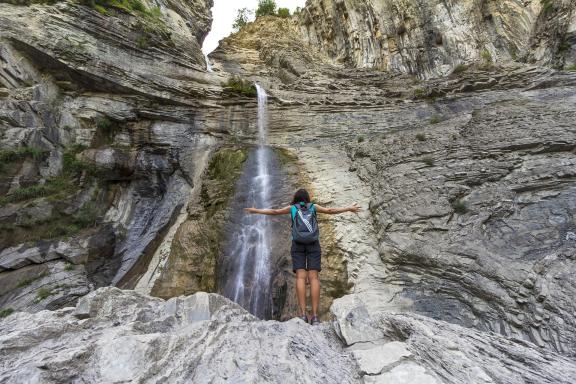
Source: Daniel Nebreda at Pixabay
It can be expensive to implement safety standards. First, you will have to pay for certification and put in place the required systems. Second, you will have to pay for a professional auditor to inspect your business and issue a certificate.
While safety certification is not mandatory, being able to prove that your tours are safe will reassure buyers.
Some important standards that you should consider complying with are:
- Adventure tourism – Safety management systems – Requirements – ISO 21101:2014. To accompany this standard, ISO has issued a practical guide for SMEs to help develop, implement and review their safety standards on an ongoing basis. It costs €40 and can be useful as a first step.
- BS 8848:2014. This is the British Standard for adventurous activities outside of the United Kingdom, developed along the lines of the ISO standard. This guide tells you all about it. To buy the standard, visit the BSI website.
- The Adventure Travel Trade Association (ATTA) has issued a standard specifically for adventure guides and guiding, in line with the ISO standard. The Adventure Travel Guide Standard (ATGS) outlines the five essential core competencies of adventure guides. These are in the areas of sustainability, technical skills, safety and risk management, customer service and group management, and natural and cultural history interpretation.
Tips:
- Purchase the ISO Practical Guide for SMEs so you know what is required. Make a note of what you have already implemented and identify what you still need to do.
- If you already comply with a standard, make sure you are very clear about this on your website and/or in your marketing materials. You will have to convince your buyers that you have high safety standards that meet their expectations.
- Investigate the costs of being certified. Read Chapter 3, What are the requirements and certifications for tourism niche markets?, of the CBI study What are the requirements for tourism services in the European market?.
- Make sure your guides are well trained. They must be professionally certified if required (as a diving instructor or wildlife guide, for instance), and they should have received suitable tourism training. They should also be able to speak the language of the visitors to a good level.
Run your business sustainably
Sustainability is the biggest challenge facing the tourism industry today. It is also something that gap year travellers feel very strongly about. They understand the impact climate change is having on the planet, and they are motivated to be part of the solution. Supporting local communities, minimising negative impacts and reducing carbon emissions are important elements of sustainable tourism. To attract the gap year market, you must integrate sustainability into your business.
The best thing you can do as a business is to obtain sustainability certification. Travelife for Tour Operators is one of the most popular sustainability schemes in the tourism industry and is particularly well known in Europe. TourCert is also growing in popularity in Europe, and the Good Travel Seal is another affordable scheme. More and more adventure tour operators are getting sustainability certification every year. ATTA’s 2023 Industry Snapshot revealed that 68% of respondents were either certified or working towards certification, up from 45% in 2021.
Figure 2: Sustainability certification schemes for tour operators
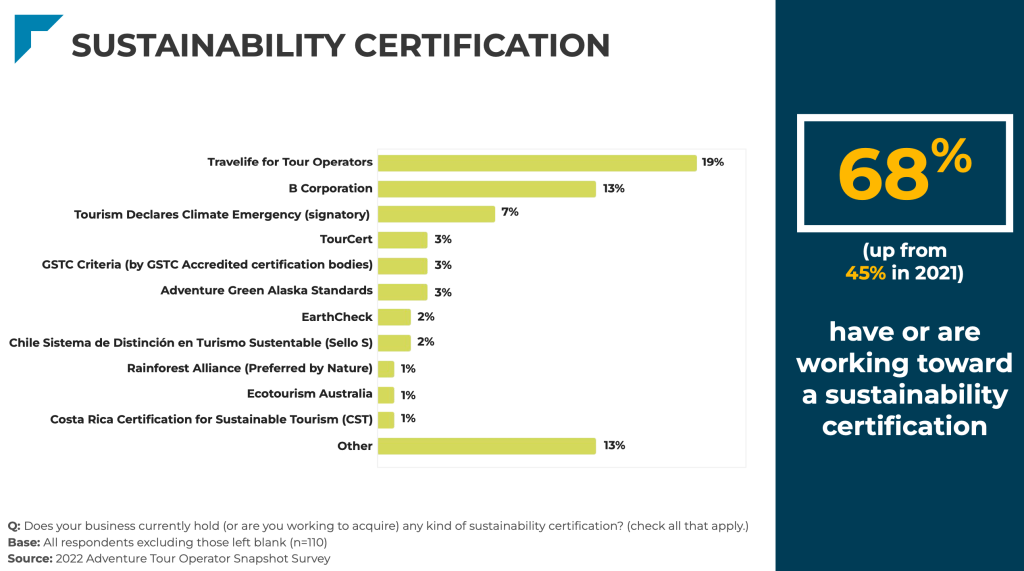
Source: 2023 Industry Snapshot, ATTA
If you are not able to become certified right now, you should still aim to be a sustainable business and use your website to tell your buyers what you are doing in this area. The Black Sheep Inn in Ecuador is a best practice example of a business that does not have sustainability certification. However, the inn’s operators do go into great detail about their eco-friendly practices. They are also active in the sector, competing for eco-awards and making sure their eco-credentials are widely publicised.
Another good example is Mdumbi Backpackers in South Africa, which is a business that promotes community involvement in sustainable ecotourism. It is staffed by locals who are part owners of the business. They also receive support to help them generate additional income through their own personal businesses.
ATTA and Travelife have published a set of useful Sustainability Codes of Best Practice for adventure tourism providers that cover each niche market. Relevant guides for gap year tourism providers include Volunteer Tourism (see infographic below), Visiting Communities and Tour Guides. Download the guidelines and find out which are suitable for your business. You may need to register, but this is free of charge.
Figure 3: Sustainable Code of Best Practice for Volunteer Tourism
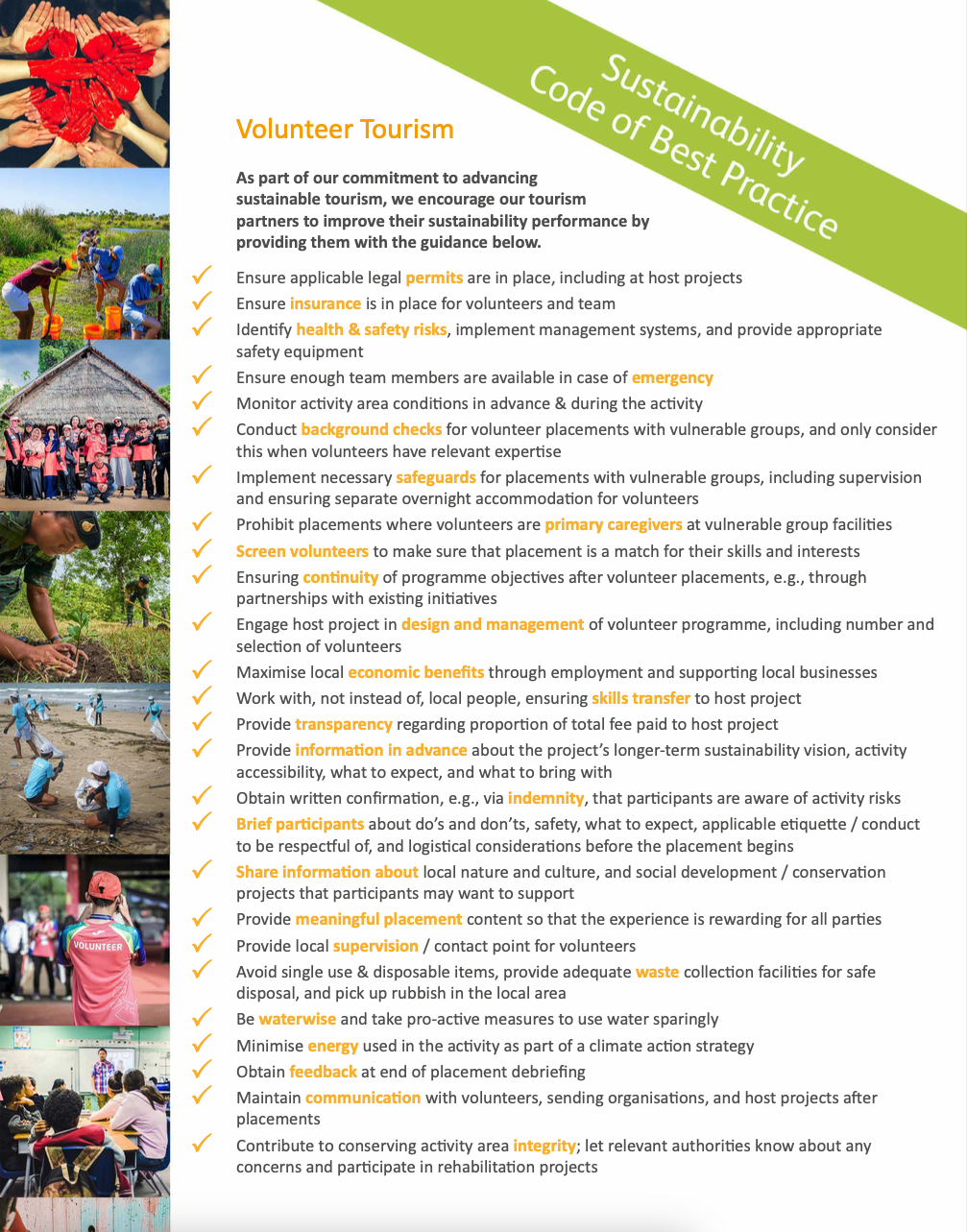
Source: ATTA
Other practical ideas you can implement cheaply and quickly:
- Encourage your staff to walk, cycle, use public transport or car-share to work. Make sure you do the same!
- Communicate with and train your staff and guides so that you are all working towards the same aim.
- Make sure your buildings (offices, accommodation) use energy-efficient LED bulbs.
- Help your gap year travellers behave responsibly. Encourage them to bring their own reusable water bottles (you will need to provide them with a safe source of water) and ban plastic straws.
- Encourage travellers to ‘leave no trace’ and take all their rubbish with them. If there is a local beach clean-up project, you could arrange for them to take part.
- If you provide accommodation, put up signs encouraging guests to turn off lights and use water sensibly to save precious resources.
- Source locally produced food wherever you can.
- Employ local people, provide suitable training and pay a fair wage.
- If you conduct your tours by vehicle, invest in electric vehicles. Although these can be expensive to purchase, prices will be coming down as much of the world strives towards net zero. See how these businesses have incorporated electric vehicles into their safari tours. Be sure to check out your local EV infrastructure before making a purchase.
Practical tips: how to set up a project for gap year travellers
If you are planning to set up a volunteer project aimed at the gap year traveller market, follow these preparation steps:
- Have a clear outline for the project – You should ask yourself questions like: what is the aim of the project and what are the desired outputs? How long will the project last? Does it require skilled or unskilled volunteers or researchers? How will you measure the project’s impact on the community and the volunteers?
- Identify the need for volunteers – Once you have a clear idea of what the project will be, assess how you plan to engage volunteers. Identify all the tasks that can be assigned to a volunteer and write a job/task description for each role you have created. You can adapt these as required later on.
- Involve staff and other community members – Make sure you get others in your community involved so they are supportive of the project. Set up a meeting so they can share their views and you can take away any fears they might have. You must be able to demonstrate to them that volunteers will be a benefit rather than a hindrance.
- Consider practical issues – Think about issues like space and equipment. Where will the volunteers stay and what equipment will they use? Do you need to build accommodation for a large group of volunteers, or do you plan to use homestays or local hostels?
- Standard of accommodation – European gap year tourists will not expect luxury accommodation, but they do want things to be clean. A basic standard is beds with bed linen, towels, a bathroom with a toilet and a door that locks, and food that is simple, locally produced and safe to consume.
- Anticipate the costs – While volunteers do not charge for their time, you must reimburse them for out-of-pocket expenses. You should also consider training costs, publicity materials that may need to be translated and any recruitment costs.
- Hire a volunteer manager or coordinator – This person will take on the responsibility for overseeing the involvement of volunteers. This will probably involve creating a volunteer strategy, writing policies and updating these as necessary, supporting staff who work with the volunteers, communicating with the volunteers (including obtaining feedback and providing acknowledgement), and monitoring, evaluating and reporting on volunteer involvement.
- Sustainability and monitoring – You must establish procedures to monitor and record the project’s impact. These might include indicators that the building was constructed on time and within budget, the number of successfully completed classes, the number of workshops held and so on.
- Provide additional activities – When the volunteers have finished their work for the day, what will they be able to do in their spare time? Think about additional activities that might appeal to them and add to their personal experience. These could include visits to other local communities, taking part in a festival, trail hiking, trips to other local attractions and taking part in other activities within the community, such as sports or language learning.
Tips:
- Find out if your country has its own sustainable tourism certification scheme that you could join. Examples include Costa Rica’s Certification for Sustainable Tourism (CST) and Responsible Tourism Tanzania (RTTZ).
- Lobby your national tourist board to see if they have any plans to develop a national certification scheme. Getting involved in an initiative like this will help you stay up to date on all the current issues.
- Tell your national tourist board about your sustainable practices so they can include you in any familiarisation trips (also known as FAM trips) and promote your business as a sustainable company.
- For more tips and advice, read the CBI studies How to be a sustainable tourism business and 10 tips to go green in the tourism sector.
Be a responsible tour operator
Working with children or animals and working on community projects are some of the most popular activities for gap year travellers. However, projects must be implemented responsibly. First and foremost, volunteer and adventure activities should empower local communities, ensure children’s safety and protect wild animals and their habitats.
Orphanage tourism and poorly managed wildlife projects are two things you must avoid if you want to attract European buyers. Gap year travellers are usually very taken by small children and ‘cuddly animals’ and often have a strong desire to ‘help’. You should not exploit this or get young Europeans involved in projects that cause harm to children or wild animals.
Figure 4: Travel Kind: the do’s and don’ts of wildlife tourism
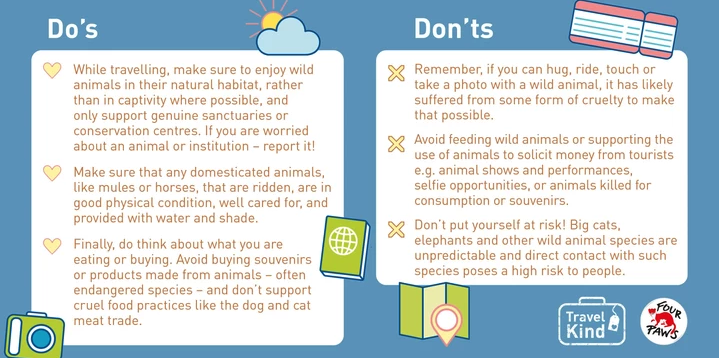
Source: Four Paws
Making sure that local communities benefit from tourism activities they provide to your guests is an essential marker of responsible tourism. Gap year tourism can involve many types of community projects, including teaching, sports coaching, healthcare assistance, working with the elderly, construction projects (building new schools and/or health centres) and day-to-day work like farming or fishing.
As a responsible tour operator, you must make sure that projects are authentic and real. Communities must be paid fairly and have access to proper skills development and training. They must be involved at all levels, ideally managing the project. A gap year volunteer should not do work that a community member could be paid to do. To find out more about community-based tourism (CBT), which is closely aligned to volunteer tourism and gap year tourism, read the CBI study What are the opportunities for community-based tourism from Europe?
Tips:
- Find out more about the problems associated with orphanage tourism and why Europeans are encouraged not to take part. The organisation Hope and Homes is working to address problems at orphanages worldwide. It has teamed up with the Association of British Travel Agents (ABTA) to help end orphanage tourism.
- Do your research on poorly managed wildlife experiences. Working Abroad provides information about ethical wildlife volunteer work. The article Cruel Wildlife Experiences to Avoid on Your Next Holiday provides the sort of information that is easily available to European travellers.
- Create your own responsible tourism policy. European buyers will be impressed that you are fully aware of these issues. Have a look at the policies of Volunteering Solutions and Natucate to help you write your own.
2. What channels can you use to attract European gap year tourists?
Five main groups of travellers make up the end-market of gap year tourism. They are served by specialist gap year tour operators that are very familiar with the needs of this group of young travellers. Other tour operators, especially adventure tour operators, also serve the market, along with online travel agents (OTAs).
How is the end-market segmented?
Gap year tourism is dominated by the youth travel market. There is also an emerging group of older travellers aged 50+ who take a ‘grey gap year’. The five main groups of gap year travellers are:
Secondary school and university graduates: this is the core group of gap year travellers. They either take a gap year between school and university or after university, and they are typically aged between 18 and 25.
Young professionals and career breakers: young people, usually aged between 25 and 35. They take time off to travel, take a break from their career (often called a sabbatical) or change jobs. Some take time off because they have lost their job.
Backpackers: backpackers are a mix of secondary school and university graduates, young professionals and career breakers. Backpackers are usually independent budget travellers.
Families: a small segment in this niche are families who take their young children out of school and travel overseas for extended periods to provide their children with a ‘life education’.
50+ market (‘grey gap year’): these are often ‘empty nesters’ with no children at home, and this group also includes retirees. They have more time and money to travel and are a growth market for the tourism industry as a whole.
There is overlap between gap year and SAVE (scientific, academic, volunteer and education) tourism. Both are dominated by the youth travel market. To find out more about the SAVE market and to see whether you can align your tourism offer with a broader market, read the CBI study What are the opportunities in the European SAVE tourism market?
Tip:
- To find out more about young traveller groups and their motivations for gap year travel, read the CBI study The European market potential for gap year tourism.
Through what channels do gap year tourism products reach the end-market?
The European market for gap year tourism is large, particularly in the UK, where gap years are a well-established concept. There is lots of crossover between European buyers, but specialist gap year tour operators, adventure tour operators and online tour operators (OTA) are the main sales channels. Independent travellers across all end-segments may also book directly with local tour operators.
Figure 5: How gap year tourism products reach the European market
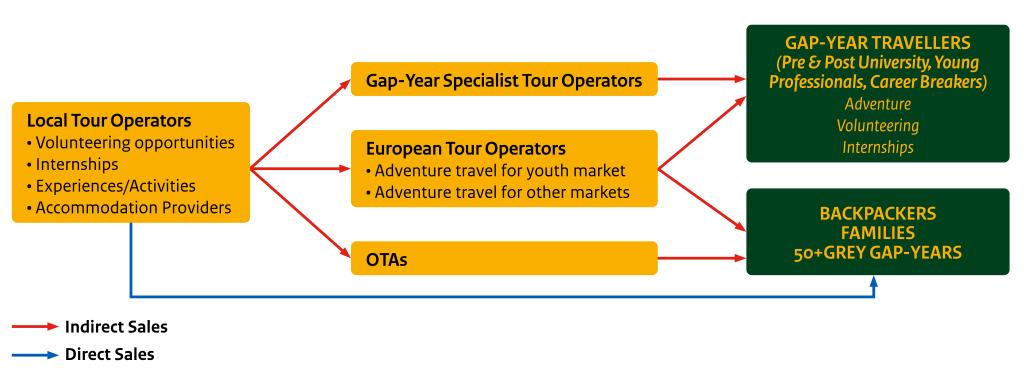
Source: Acorn Tourism Consulting
The channels are further described as follows:
- Specialist gap year tour operators: these tour operators aim their products specifically at gap year travellers, typically aged 18 to 25 (secondary school or university graduates). A number of them also cater for the teenage market, usually secondary school pupils between the ages of 15 and 17.
- European tour operators: the youth travel market is substantial, accounting for 23% of all international arrivals. That is why many general European tour operators tailor some of their itineraries to this market. These are often adventure tour operators marketing their products in a variety of ways, using labels like ‘gap year’, ‘teenagers’, ‘18-30’ and ‘young people’.
- OTAs: in this niche, OTAs are used by independent travellers across the end-market segments. They will use an OTA to supplement their trips, booking experiences either before or during their travels. There are two types of OTAs used by gap year travellers. General OTAs offer single-day excursions or multi-day trips across a range of different themes, including adventure. But there is also a small group of specialist OTAs that offer volunteer experiences. Examples of both types are listed in Table 2 below.
- Direct sales: if you have your own website and use your social media platforms to drive traffic, independent gap year travellers may want to book directly with you. This market is extremely tech savvy and uses the internet and social media for all sorts of reasons, including research and travel.
Table 1: Examples of European tour operators in the gap year tourism niche
Specialist gap year tour operators Sell gap year programmes only | European tour operators Sell adventure group travel that appeals to the youth market |
UK
Germany
France
Scandinavia
Netherlands
Italy
| UK
Germany
France
Scandinavia
Netherlands
Italy
|
Table 2: OTAs selling experiences to the youth market
| OTAs |
General OTAs
Volunteer OTAs
|
Finding buyers and doing business in the youth travel market segment
The gap year and youth travel market segments are well supported by a range of travel associations. These offer resources and information to support young travellers and their families, and to help them with their decision-making. The youth travel market industry is also supported by various organisations that do research and organise travel fairs.
- The World Youth Student and Educational Travel Confederation (WYSE Travel Confederation) is a global network of youth travel professionals. It is a non-profit that provides business-to-business (B2B) trading opportunities, publishes industry research and has a strong network. There are several membership options, most of which include discounts on tickets to the network’s annual World Youth and Student Travel Conference (WYSTC).
The WYSE Travel Confederation has published two reports about the global youth travel market together with the United Nations World Tourism Organisation (UNWTO): Global Report on the Power of Youth Travel (2016) and The power of youth travel (2011). You should read these to build your knowledge of the market.
- The Year Out Group is an association of UK gap year tour operators. Members of the group undergo a rigorous assessment to check that they are financially healthy and fully insured, and that they have risk and crisis management plans in place. This is essential when working with the youth travel market. Businesses registered with the Year Out Group will be sure to check that you are similarly business savvy. Browse the approved providers list to find suitable companies to work with.
Figure 6: Membership of the Year Out Group

Source: Year Out Group
- Impact Travel Group is a group of educational and experiential travel brands. Its mission is to create meaningful travel experiences that contribute to cultural, economic and environmental sustainability. Have a look at the companies that are part of this group to find potential business partners.
- The British Educational Travel Association (BETA) is a membership organisation for businesses in the youth, student and educational travel industry. Its members work in many areas of this market, including gap year, volunteer and adventure travel. You can search BETA’s member database for suitable tour operators to approach.
- The German-based association Wege ins Ausland working group is similar to the Year Out Group. It provides advice and resources to young Germans seeking to go abroad to study or travel. The organisation has 11 members.
- The JuBi Youth Education Fair is a German event that takes place in more than 50 locations across the country. It is a specialist consumer fair for young Germans looking to travel overseas – to study abroad, volunteer, do a student exchange, work or travel. There is a long list of exhibitors to browse.
Tour operator insight: tips for gap year suppliers to market themselves better and gain access to the European market

Ellison Fellers, Project Manager and Sustainability Coordinator, KILROY
In an increasingly saturated travel and tourism industry, the influence of social media further intensifies the competition. To stand out from the crowd, it’s crucial to develop offerings that go beyond the conventional. Take the time to understand the current needs and trends and create innovative experiences that are unique to your local culture and environment.
For instance, consider catering to the preferences of younger travellers who are increasingly drawn to outdoor adventures and wellness-oriented activities. Rethink the standard travel experiences that have been offered for decades and focus on crafting experiences that bring genuine value to your customers.
When you have a compelling concept in mind, start networking and building connections within the industry. Test your ideas on OTA platforms like Get Your Guide, Tripadvisor and Viator to gauge interest and gather feedback. These platforms offer lower barriers of entry compared to starting your own agency, allowing you to validate your offerings before committing to larger-scale operations.
By staying in tune with travellers’ needs, innovating unique experiences and using digital platforms to do trial runs, you can attract attention in the competitive travel market. Embrace the spirit of creativity and adaptability, and you’ll be well on your way to success.
What is the most interesting channel for you?
Specialist gap year and adventure tour operators are both interesting channels for you if you want to attract gap year travellers and the wider youth market. To assess whether your tour will be suitable for them, look closely at what they offer their young travellers. Keep in mind that you will need to have robust safety standards in place to do business with these operators.
OTAs are a convenient way to reach independent gap year travellers, especially backpackers. Young people do much of their travel research online and are very familiar with booking online as well. To work with OTAs, you will need to be very well organised and know how to operate in this dynamic market.
If you manage a volunteer project for gap year travellers, you should consider becoming a host on a volunteer OTA like Worldpackers or Volunteer World. You will need to submit all the details of your project to the platform, which will generally assess your business before agreeing to list your project.
Tips:
- Build your own website to showcase your tours and tailor the design to attract young people. They want adventure, exciting experiences and to learn new things, and videos and strong images appeal to them. If you are starting a new business or want to improve your existing website, use the CBI study How to be a successful tourism company online?.
- Price your tours carefully for the backpacking market, as these travellers are usually on a tight budget. Read the What are the prices for gap year tourism products section below for pricing tips. Consult the CBI study How to work effectively with OTAs? to help you decide which OTAs to work with and for advice on how to list your tours on these platforms.
- Read the business studies 10 tips for finding buyers on the European market and 10 tips for doing business with European tourism buyers to help you approach European tour operators. They will also want to know how you keep younger travellers safe.
3. What competition will you face in the gap year tourism market?
The global gap year tourism market is highly competitive. Still, developing countries are very popular, as young people are keen to visit different countries and have experiences they would never have in their normal lives. This means that there are plenty of opportunities for destinations and businesses to compete in this market.
Which countries are you competing with?
There are many competing destinations for gap year tourism. Thailand, Brazil, South Africa, India, Peru and Ghana are all popular destinations for young travellers. But you should also consider other destinations, such as Mexico, Guatemala, Costa Rica, Ecuador, Bolivia, Argentina, Tanzania, Kenya, Nepal, Vietnam and Cambodia.
Thailand
Thailand is believed to be the top destination for gap year tourism. Gap year students, backpackers, families, and 50+ travellers continue to be drawn to its famous, beautiful tropical islands like Koh Phi Phi or Koh Samui with their idyllic beaches, sparkling seas and friendly hospitality. Meanwhile, Bangkok is a very popular city with beautiful temples and buzzy nightlife. The northern hill regions of Chiang Mai and Chiang Rai are also popular destinations for visiting remote hill tribes and trekking.
The country offers all kinds of volunteer opportunities, from marine conservation and teaching English to monks in Chiang Mai to working in an elephant village. Elephant tourism is a controversial topic, and tourists are encouraged to only visit and work in ethical elephant sanctuaries.
Thailand is also one of the cheapest travel destinations, making it popular amongst backpackers and travellers on a budget.
Brazil
Brazil’s enormous size makes it ideal for gap year and adventure tourism. There is a huge amount of natural and cultural diversity, and the Amazon is the world’s largest river system and home to remote tribes. Rio de Janeiro is a top destination, famous for Copacabana Beach, the Rio Carnival and the famous Christ the Redeemer statue. Throughout the country, tropical rainforest, deserts and beautiful beaches provides endless opportunities for adventure.
Volunteering opportunities in Brazil are highly varied. Options include community projects, teaching English in the favelas of Rio de Janeiro and São Paulo, youth sports programmes and working on construction projects. Many disadvantaged children live in urban slums and poor rural areas, and projects to support them are common. Conservation of wildlife and rainforest preservation are also common volunteering projects. Conservation and environmental internships offer opportunities to help protect the Amazon rainforest’s biological diversity.
Brazil can be one of the more expensive destinations for gap year tourism, particularly in the cities.
South Africa
South Africa has a diverse landscape, but it is best known for its sprawling savannahs, full of iconic African wildlife. As one of the world’s top safari destinations, it is often a ‘must-do’ for gap year tourists. South Africa’s big cities, such as Cape Town and Johannesburg, are exciting places to visit.
The country offers a huge range of gap year opportunities. Travellers can do volunteer work in townships, for instance, coaching sports or providing healthcare. There are also other opportunities, particularly in wildlife conservation. Adventure tourism is a big market in South Africa, and in addition to safaris, ‘gappers’ can go trekking, biking, bungee jumping or shark diving in Cape Town.
It is easy to get around in South Africa, as there are good transportation options. The cost of living is lower than in Europe, but as with many destinations, cities can be more expensive.
Figure 7: Gap year jungle hike
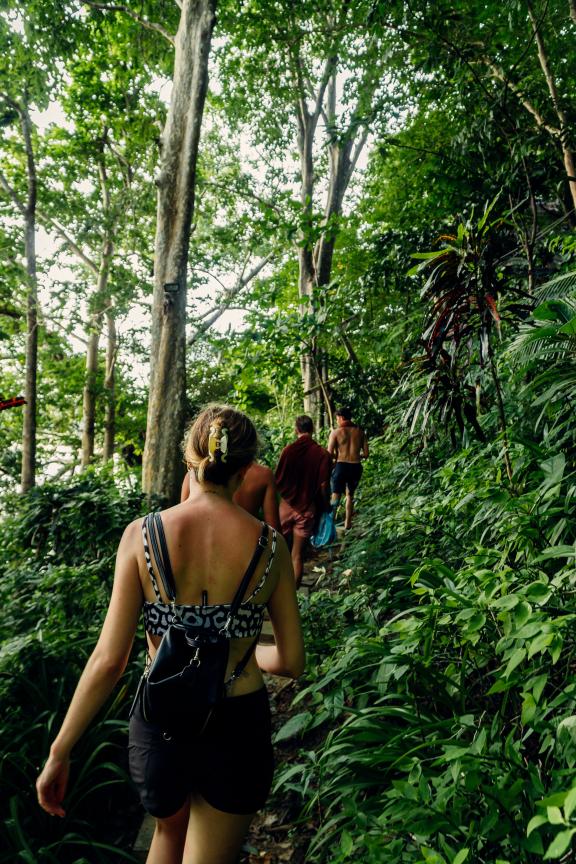
Source: Photo by Alain Gehri on Unsplash
India
India is an extremely popular gap year destination, particularly for UK gappers, who have been visiting India for a long time. It is a very diverse country, from the snow-capped Himalayas in the north to the deserts and palaces of Rajasthan and the tropical landscape and houseboats of Kerala in the south. It is also one of the cheapest destinations to visit, which adds to its appeal.
There are many volunteering opportunities in India: gap year travellers can teach English, assist in providing healthcare, work in environmental conservation or contribute to community development. It is possible to volunteer through local charities and NGOs, as well as through European gap year companies. India offers all kinds of adventure travel. Viewing tigers in their natural habitat is a highlight, and tourists can do treks, go on desert safaris by camel and enjoy many cultural activities.
Peru
Peru is a leading destination for gap year tourism and backpacking. Its most famous attractions, Machu Picchu and the Inca Trail, are top places to visit. Spectacular natural attractions extend from the high Andes mountains through rainforest to coastal deserts. Peru is also well known for its world-class cuisine.
Many volunteering opportunities focus on local communities. This includes caregiving, healthcare work and teaching English. Internships are usually 1 to 3 months, and interns are often hosted by local families, where they learn about traditional Peruvian cultures and ways of living. This is very popular amongst gap year travellers. Peru’s distinct geographical regions offer a wide range of adventure activities, such as hiking and trekking on mountain trails, visiting ancient ruins and sand dune buggying.
Ghana
As West Africa’s top destination for gap year tourism, Ghana is one of the most popular countries in Africa for gappers. It is a settled, stable country, and Ghanaians speak English to a high level. Ghana is closer to Europe than other long-haul markets, making it a convenient choice for European gap year travellers.
Ghana has a unique culture that is a mix of traditional West African and colonial elements, plus the hustle and bustle of modern life. Volunteer work and internships are particularly popular amongst gappers travelling to Ghana.
Key takeaways:
- Do research to find out where gap year students and young people go in your destination. Make a list of all the things they like to do – this could include adventure experiences, conservation activities, volunteer work or learning a language. Assess whether your offer meets their needs.
- If your destination promotes wildlife experiences or working with children as a gap year activity, find out whether these are responsible projects. Check what they say about their responsible tourism principles and code of conduct on their website. It is essential that all activities are responsibly managed, or Europeans will not want to do business with you.
- European gap year travellers of all types are keen to get involved in a wide range of adventure and volunteering activities. If you do your research well, there is lots of opportunity for you to develop programmes that appeal to them.
Which companies are you competing with?
There are many good businesses offering volunteering and adventure products for the gap year market. Some have their own website, others use Facebook. Both are effective ways to attract gap year travellers. This section offers snapshots of various tourism businesses around the world.
Thailand
Courageous Kitchen hosts cooking classes and experiences in Bangkok – perfect for gap year travellers who want to get a taste of the local cuisine and learn new skills. Experiences will typically include two to three meals, a stroll through a local Thai market and homemade drinks. All the food is plant-based, so people with dietary restrictions can also enjoy it. Vegetarianism and veganism are key trends in Europe, particularly amongst younger age groups. A main draw of gap year travel is the opportunity to try local food, making these experiences perfect for those who want to cook authentic dishes.
In rural Chiang Mai, the Ing-Asai Community & Farm welcomes volunteers in the summer months to help with gardening, farming and repairs. Respect for nature is important to this small community, which aims to become self-sufficient within the next five years. This is a great opportunity for gap year travellers who want to give back to the environment. Meals and facilities are included, adding further appeal for budget travellers. The local community is happy to give free tours of the local area to volunteers.
Brazil
Jungle Me provides English-language nature experiences and hiking tours across Rio de Janeiro. Their tours range in difficulty to cater for people of all abilities, and travellers can choose between secluded beaches, mountains, national parks, waterfalls and historical ruins. Most tours are in small groups, with a maximum of six participants, and private tours are available as well. The operator is a member of the Brazilian ecotourism associations Associação Brasileira das Empresas (ABETA) and Associação Carioca de Turismo de Aventura (ACTA). The company also has carbon neutral certification.
Located in and around Curitiba and Florianópolis, Brazilian Experience offers volunteering experiences in community centres, wildlife sanctuaries and rescue centres. Their programmes tend to be long-term, and homestay accommodation with a family is provided, as well as Portuguese language classes for some projects. Groups and young people are especially welcome, and most programmes require no prior qualifications or educational requirements, which is ideal for pre-university gap year travellers.
South Africa
From June to December, Percy Tours provides boat trips for travellers who want to see South Africa’s beautiful ocean wildlife. Depending on the time of year, humpback, southern right and Bryde’s whales can be spotted, along with a variety of dolphins, seals, penguins and pelagic birds. Wildlife viewing is popular amongst young people. For more adventurous gap year students, Percy Tours also offers kayaking, quad biking and even great white cage diving. The company has received numerous Tripadvisor awards.
WildX Adventures offers outdoor experiences and tours around Cape Town and the Garden Route. Though particularly known for their quad biking tours, they also offer paragliding, Segway tours and sandboarding. The company’s most popular experience is quad biking on the picturesque white sand dunes of Witzands Aquifer Nature Reserve. Prices include one quad bike per person, and professional photo opportunities are also available. All tours are guided by experts. Note how the website’s bright colours, multiple ‘book here’ buttons and fun images directly appeal to young travellers.
The Ing-Asai Community and Farm is an example of a volunteer project that uses an OTA to market and sell its project. The community does not have a website, but it does have a Facebook page. Volunteer applications are accepted via Worldpackers.
India
Bishnoi Village Safari in the northwest of India offers several safari options, giving visitors a unique glimpse into some of India’s rural culture away from the capital. Proceeds from the tours go to the village itself, which embraces nature and works to conserve the environment – something that appeals to eco-conscious gap year travellers. Camel and leopard safaris are available, as well as the village safari, which involves meeting the villagers and learning some of the local crafts, such as pottery and weaving.
Volunteering With India is open to female volunteers year round. It focuses on female empowerment and programmes for underprivileged young women. These programmes centre around teaching women basic numeracy and literacy skills. No qualifications are required, which is perfect for pre-university students, and all accommodation, food and transportation are included. Volunteers have two days off a week to explore the city and experience complimentary tours arranged by the VWI staff.
Peru
With a range of activities and tours to choose from, Perú Andes Top is a popular choice for gap year travellers who want to experience local attractions. They offer everything from Machu Picchu walking tours to cooking classes, Inca Trail hikes and paragliding, with options to suit all budgets. A portion of revenue is shared with local Andean communities, and the company organises campaigns for school supplies, health services and recreational activities.
RAREC is a non-profit organisation dedicated to the rescue and rehabilitation of confiscated or injured animals. Located in the heart of the Peruvian Amazon, they accept volunteers year round. The organisation also has a large number of reviews from young people who have taken part in its programmes. Participants can meet a colourful variety of animal residents, such as manatees, monkeys, tropical birds and ocelots. For students looking to continue working for RAREC after their volunteer programme finishes, special internships are offered which provide a perfect introduction to a career in animal conservation.
Ghana
Kaya Tours appeals to young travellers of all abilities and preferences, with tours geared towards local history, adventure and safaris. For those interested in culture, touring local towns and slave trade dungeons are popular choices. More daring travellers may prefer the rainforest canopy walk or adventure hike. Kaya Tours’ experiences are very budget-friendly and often include free transport and a meal – perfect for gap year travellers.
Atlas Volunteers is based in rural Kwahu, Ghana, with affordable volunteering options in different areas. Volunteers can work for animal rescue organisations, contribute to sports development, provide childcare or do renovation work. The team is made up of former volunteers, and the organisation’s projects cater for young people, which is also reflected in its lower prices. Atlas Volunteers’ newest volunteer experience is a sea turtle conservation programme from September to March, which is significantly more affordable than competing projects.
Key takeaways:
- Make sure you have lots of choices for gap year travellers. Often, they are keen to try new things, so the more exciting options you have to attract them, the more likely they will be to choose your products. It is even better if you can offer a good mix of experiences, for instance adventure activities in combination with volunteer work.
- Be sure to add value where you can, as gap year travellers are usually on a tight budget. For instance, offer free tours to local villages or free guided hikes around the local area. Or you could provide complimentary transportation/transfers to local towns and attractions for gap year volunteers on their day off.
- On your website, promote your membership of any national or local tourism associations, as well as any sustainability certificates you might have. This will impress European buyers and reassure them that you are committed to tourism excellence and sustainability.
- If you manage a volunteer project, consider using a specialist volunteer OTA to host your projects. Do research to find out which would be the most suitable platform for your business.
Which products are you competing with?
Adventure tourism is your biggest competitor. Young people are naturally attracted to adventure, and they will use the internet and social media to find out what they want to do. This is why it is so important to have a strong digital presence.
Tips:
- Take a critical look at your current offer. Ask yourself whether they are appealing to the gap year market and what improvements you could make. Assess how you could add value and make your products stand out from others.
- Consult the CBI study What are the opportunities in the European market for adventure tourism for more detailed information about adventure tourism and the characteristics and motivations of adventure tourists.
4. What are the prices for gap year tourism products?
Gap year tourism products from specialist gap year providers can be expensive. However, there is no standard, and prices vary widely. For a fully guided holiday, tour operators put together the whole trip (with or without international airfares), which generally includes everything from local transportation to accommodation, meals, guides and other staff. If a trip includes volunteer work, training, orientation by experienced staff and volunteer management are additional costs.
Figure 8 below shows how gap year provider Projects Abroad breaks down the costs of its trips. The largest share is made up of costs directly and indirectly associated with the in-country experience, such as food, accommodation, local transport and insurance premiums, along with in-country staff and project costs.
Figure 8: How volunteer fees are allocated by Projects Abroad
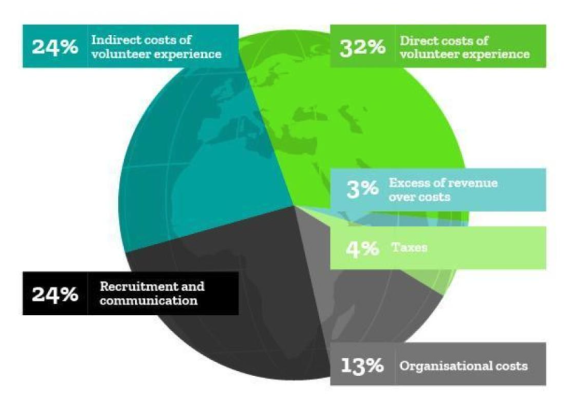
Source: Projects Abroad
For independent gap year travellers, prices also vary depending on the activity, duration, accessibility and destination. Have a look at Table 3 below for an overview of current market prices for typical products that appeal to gap year travellers.
Table 3: Examples of travel experiences in the European market, August 2023
| Experience | Country | Duration | Price per person (€) |
| Bishnoi Village Safari Day Tours | India | 5 hours | 28 |
| Atlantis Dunes Quad Biking | South Africa | 1 hour | 40 |
| Railay Beach Climbing Tours | Thailand | 4 hours | 40 |
| Thai Plant-Based Cooking Class | Thailand | 3.5 hours | 45 |
| Mystic Jaisalmer Night Camel Safari | India | 8 hours | 48 |
| Adventure & History at Tijuca Forest | Brazil | 6 hours | 55 |
| Hermanus Whale Watching | South Africa | 2.5 hours | 61 |
| Prainha & Gumari: Hike + Swim | Brazil | 8 hours | 71 |
| Paragliding in the Sacred Valley of the Incas | Peru | 5 hours | 101 |
| Great White & Copper Shark Cage Diving | South Africa | 4 hours | 115 |
| Adventure Hiking, Boat Cruise and Mini Safari | Ghana | Full day | 156 |
| Slave Trade Dungeons Visit and Rainforest Canopy Walk | Ghana | Full day | 175 |
| Women’s Empowerment Volunteering | India | 1 week | 230 |
| Taj Mahal and Tiger Safari Tour | India | 3 days | 230 |
| Machu Picchu Full Day Tour | Peru | 1 day | 274 |
| Creating a Food Forest at Ing-Asai Community Farm | Thailand | 3 weeks | 359 |
| Community Centre Volunteering | Brazil | 2 weeks | 855 |
| Wildlife Conservation in the Amazon | Peru | 2 weeks | 957 |
Source: Acorn Tourism Consulting
Tips:
- Have a look at the prices charged by European specialist gap year providers to get an idea of what gap year travellers are paying for their trips.
- Do research to find out what your competitors are charging for similar trips. Assess whether you are charging more or less for the same type of experience. If you are charging more, make sure you add value or differentiate your product to justify your higher prices.
- Read this helpful guide on pricing your tourism product. You can also consult Section 7, Set a fair price for your services, of the CBI study Tips for doing business with European tourism buyers.
Acorn Tourism Consulting Limited carried out this study on behalf of CBI.
Please review our market information disclaimer.
Search
Enter search terms to find market research
